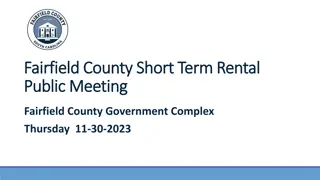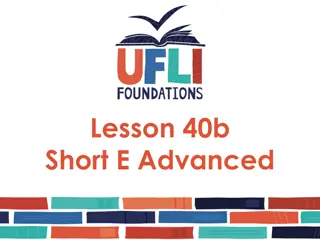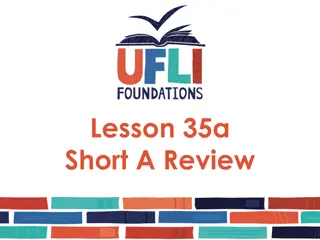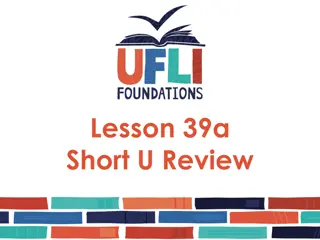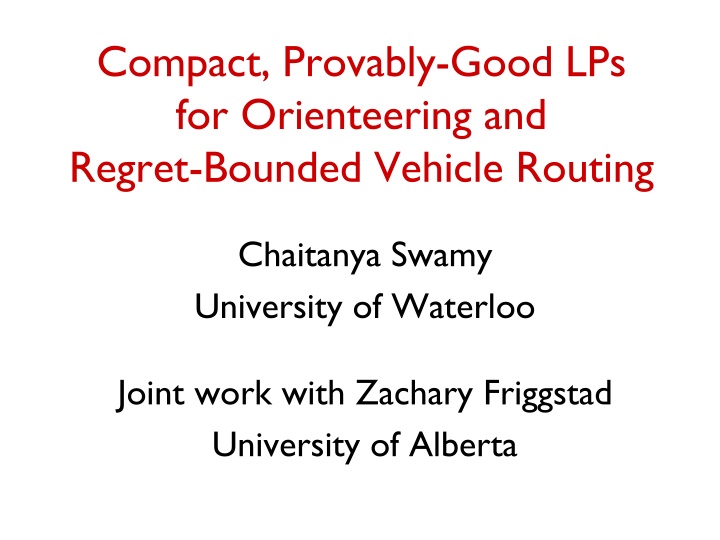
Compact LPs for Orienteering and Regret-Bounded Vehicle Routing
Explore the concept of compact, provably good LPs for orienteering and regret-bounded vehicle routing in computational methods for solving vehicle-routing problems. Understand how regret-bounded VRPs adopt a client-centric view to minimize delays and enhance client satisfaction.
Download Presentation

Please find below an Image/Link to download the presentation.
The content on the website is provided AS IS for your information and personal use only. It may not be sold, licensed, or shared on other websites without obtaining consent from the author. If you encounter any issues during the download, it is possible that the publisher has removed the file from their server.
You are allowed to download the files provided on this website for personal or commercial use, subject to the condition that they are used lawfully. All files are the property of their respective owners.
The content on the website is provided AS IS for your information and personal use only. It may not be sold, licensed, or shared on other websites without obtaining consent from the author.
E N D
Presentation Transcript
Compact, Provably-Good LPs for Orienteering and Regret-Bounded Vehicle Routing Chaitanya Swamy University of Waterloo Joint work with Zachary Friggstad University of Alberta
Orienteering Metric space 7 5 3 5 root r 2 nodes with rewards ( 0) 5 r (v)node v 2 2 reward of v
Orienteering Metric space 7 5 3 5 root r ( (r) = 0) 2 P nodes with rewards ( 0) 5 r (v)node v 2 2 reward of v (P) = 24 length bound B Rooted orienteering: find r-rooted path P of length B that collects maximum reward (P) := v P (v) Point-to-point (P2P) orienteering: also given end-node t; find r-t path P of length B collecting max reward (P) NP-hard; -approximation get reward (optimum)/
Orienteering is a basic vehicle-routing problem (VRP) Natural, well-motivated problem Arises as a subroutine both in designing approximation algorithms for various VRPs: deadline TSP, minimum-latency problems computational methods for solving VRPs: pricing problem encountered in solving set-covering LPs configuration LPs via column-generation based approach
Regret-bounded VRP (RVRP) Metric space r root r node/client Typical VRP setup: visit all clients via route(s) starting from r so as to minimize client delays: e.g., max client delay (TSP) But this does not differentiate between clients close to the depot and those far away from it Nearer clients may face more delay than further-away clients source of dissatisfaction
Regret-bounded VRP (RVRP) Metric space r root r node/client Adopt a more client-centric view: seek bounded client regret regret of client v = (waiting time of v) (shortest-path distance from r to v)
Regret-bounded VRP (RVRP) cP(v) Metric space r root r P node/client v Dv cP(v) = time to reach v along P Adopt more client-centric view: ensure bounded client regret regret of client v = (waiting time of v) (shortest-path distance from r to v) Dv (min. possible waiting time of v) RVRP: Given regret bound R, find minimum no. of r-rooted paths that cover all clients s.t. regret of every client R
For a rooted path P, let regret of P := regret of end-node of P c(P) Dend node of P
For a rooted path P, let regret of P := regret of end-node of P Let C(R) = {rooted paths P: regret of P R} Minimize P C(R) xP s.t. P C(R): v P xP 1 v V x 0 (LP) (LP) is a set-cover LP can get O(log n)-approximation using greedy algorithm for set cover greedy step (find path in C(R) covering max. # of new nodes) (P2P-) orienteering In fact, (LP) has O(1) integrality gap (Friggstad-S 14) To approximately solve (LP) in polytime via ellipsoid, need to solve the dual; dual separation problem is again orienteering Solving (LP) by column generation: pricing problem orienteering
Our results Give natural, compact LP-relaxation for rooted orienteering + simple LP-rounding 3-approximation algorithm First, LP-based guarantee for orienteering.
Our results Give natural, compact LP-relaxation for rooted orienteering + simple LP-rounding 3-approximation algorithm First, LP-based guarantee for orienteering. All previous approaches (Blum et al., Bansal et al., Chekuri et al.) used dynamic programming (DP) to stitch together subpaths, which are found using another DP, or by solving a k-MST style problem. Our approach gives a clean, simple algorithm. Ideas may lead to compact, strong LPs for other problems that use orienteering (we show this for RVRP). LP-based insights are often versatile and adaptable to handle variants of the problem. DP-based approach gives (2+ )-approximation (Chekuri et al.); it is likely however that our 3-approximation guarantee is not tight.
Our results Give natural, compact LP-relaxation for rooted orienteering + simple LP-rounding 3-approximation algorithm First, LP-based guarantee for orienteering. Ideas may lead to compact, strong LPs for other problems that use orienteering (we show this for RVRP). Show that P2P-orienteering reduces to regret-version of rooted orienteering (length bound is replaced by regret bound) losing a factor of 2 No such reduction to a rooted problem was known: all previous approaches relied on approximations for P2P-path problems LP for rooted orienteering extends to regret version get LP for P2P-orienteering with integrality gap 6
Our results (contd.) For RVRP, we propose two compact (i.e., poly-size) LP-relaxations with small integrality gaps First LP adapts orienteering-LP to RVRP yields15-approx. for RVRP Second LP is an unorthodox LP that exploits structural insights about an RVRP solution Both LPs have efficient LP-rounding algorithms: lead to improvements over previous-best O(1)-approx. for RVRP (Friggstad-S 14) (and substantial savings in running time)
Compact LP for orienteering cuv Metric space complete graph Bidirect edges to get digraph (view rooted path as directed away from r) Suppose we know node w on optimum path with largest Dv cuv u v u v cuv w r shortest-path distance from r to v
Compact LP for orienteering cuv Metric space complete graph Bidirect edges to get digraph (view rooted path as directed away from r) Suppose we know node w on optimum path with largest Dv zwu : indicates if node u lies on path xwa : indictes if arc a lies on path cuv u v u v cuv Maximize u (u)zwu subject to, xw( in(u)) xw( out(u)) xw( out(r)) = 1, xw( in(u)) = 0 for all u: Du > Dw a ca xwa B xw( in(S)) zwu zww = 1, for all u r r x, z 0. S for all S: r S, u S u
Compact LP for orienteering cuv Metric space complete graph Bidirect edges to get digraph (view rooted path as directed away from r) Suppose we know node w on optimum path with largest Dv zwu : indicates if node u lies on path xwa : indictes if arc a lies on path cuv u v u v cuv xw: r-preflow of value 1 (relaxation of rooted path) Maximize u (u)zwu subject to, xw( in(u)) xw( out(u)) xw( out(r)) = 1, xw( in(u)) = 0 for all u: Du > Dw a ca xwa B xw( in(S)) zwu zww = 1, for all u r r x, z 0. S for all S: r S, u S u
Compact LP for orienteering cuv Metric space complete graph Bidirect edges to get digraph (view rooted path as directed away from r) Suppose we know node w on optimum path with largest Dv zwu : indicates if node u lies on path xwa : indictes if arc a lies on path cuv u v u v cuv Maximize u (u)zwu subject to, xw( in(u)) xw( out(u)) xw( out(r)) = 1, xw( in(u)) = 0 for all u: Du > Dw a ca xwa B xw( in(S)) zwu zww = 1, for all u r can be encoded by polynomial # of flow constraints r x, z 0. S for all S: r S, u S u
Compact LP for orienteering Suppose we know node w on optimum path with largest Dv zwu : if node u lies on path, xwa : if arc a lies on path Maximize u (u)zwu subject to, xw( in(u)) xw( out(u)) xw( out(r)) = 1, xw( in(u)) = 0 for all u: Du > Dw a ca xwa B xw( in(S)) zwu zww = 1, Constraints ensure: zwu zww for all u, Can eliminate need for knowing w (use zww to denote if w is furthest node on optimum path; modify constraints suitably) (O-P) for all u r x, z 0. for all S: r S, u S zwu = 0 if Du > Dw
Rounding algorithm Let ( ?, ?): optimal solution to (O-P), OPT = value of ( ?, ?) Key insight: ? can be viewed as an arborescence packing 0.1 w 0.1 + r 0.6 0.6 w 0.1 0.3 0.1 r 0.5 0.1 0.3 0.3 0.30.3 0.1 w 0.3 r w r 0.3 + w r +
Rounding algorithm Let ( ?, ?): optimal solution to (O-P), OPT = value of ( ?, ?) Key insight: ? can be viewed as an arborescence packing Theorem (Bang-Jensen et al. 95): There are out-arborescences T1, ,Tq rooted at r with weights ?1, ,?? 0 such that: i?? = 1 (total ?-weight of Ti s containing arc a) ?? (total ?-weight of Ti s containing node u) ?? (Every Ti contains w; nodes u with Du > Dw are not in any Ti) ? for every arc a ? for every node u Can obtain the (Ti , ??) pairs in polytime (Gabow 96, Post-S 15) Theorem: Can round ( ?, ?) to obtain path with reward OPT/3.
Rounding algorithm Let ( ?, ?): optimal solution to (O-P), OPT = value of ( ?, ?) Theorem (Bang-Jensen et al. 95): There are out-arborescences T1, ,Tq rooted at r with weights ?1, ,?? 0, i?? = 1 s.t. (total ?-weight of Ti s containing arc a) ?? (total ?-weight of Ti s containing node u) ?? (Every Ti contains w; nodes u with Du > Dw are not in any Ti) Algorithm: 1) Obtain (Ti , ??) pairs satisfying above properties. 2) Convert every Ti to an r-w path Pi s.t. c(Pi) 2c(Ti) Dw So i??.c(Pi) 2B Dw i??.(regret of Pi) 2(B Dw), i??. (Pi) OPT ? for every arc a ? for every node u
Rounding algorithm Let ( ?, ?): optimal solution to (O-P), OPT = value of ( ?, ?) Algorithm: 1) Obtain (Ti , ??) pairs as in arborescence-packing theorem. (Every Ti contains w, nodes u with Du > Dw are not in any Ti) 2) Convert every Ti to an r-w path Pi s.t. c(Pi) 2c(Ti) Dw So i??.(regret of Pi) 2(B Dw), 3) Path-splitting lemma: a rooted path P of regret R, can be split into at most (1+ ) rooted paths, each of regret R. i??. (Pi) OPT r
Rounding algorithm Let ( ?, ?): optimal solution to (O-P), OPT = value of ( ?, ?) Algorithm: 1) Obtain (Ti , ??) pairs as in arborescence-packing theorem. (Every Ti contains w, nodes u with Du > Dw are not in any Ti) 2) Convert every Ti to an r-w path Pi s.t. c(Pi) 2c(Ti) Dw So i??.(regret of Pi) 2(B Dw), 3) Path-splitting lemma: a rooted path P of regret R, can be split into at most (1+ ) rooted paths, each of regret R. i??. (Pi) OPT r
Rounding algorithm Let ( ?, ?): optimal solution to (O-P), OPT = value of ( ?, ?) Algorithm: 1) Obtain (Ti , ??) pairs as in arborescence-packing theorem. (Every Ti contains w, nodes u with Du > Dw are not in any Ti) 2) Convert every Ti to an r-w path Pi s.t. c(Pi) 2c(Ti) Dw So i??.(regret of Pi) 2(B Dw), 3) Path-splitting lemma: a rooted path P of regret R, can be split into at most (1+ ) rooted paths, each of regret R. Apply path-splitting lemma with R = B Dw to each Pi: obtain collection of rooted paths s.t. each path has regret B Dw , ends at some u with Du Dw total ?-weight of paths 3, total ?-weighted reward OPT i??. (Pi) OPT has length B 4) Return max-reward path in collection: get reward OPT/3
Conclusions and open questions Give compact LP-relaxations for orienteering and RVRP, devise LP-rounding algorithms for orienteering and RVRP 3-approx. for rooted orienteering: first LP-based guarantee, simple rounding algorithm using arborescence packings Reduce P2P-orienteering to rooted regret-version of orienteering losing a factor of 2 Two compact LPs for RVRP, one of which leads to 15-approx. for RVRP Recent work: can solve prize-collecting version of (O-P) and obtain arborescences combinatorially (Post-S 17) What is the integrality gap of (O-P)? Believe 2 is the right answer Better algorithms for 2 prominent generalizations of orienteering: Deadline TSP: nodes with deadlines, get reward if visited by deadline Submodular orienteering: reward function is submodular Can our ideas/insights help?






